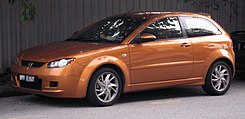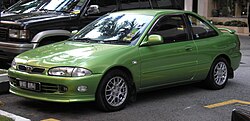Satria (1995-2005)
 | |
| Also called | Proton Compact Proton Persona Compact Proton 300 series |
|---|---|
| Production | 1995–2006 |
| Engine(s) | 1.3 L 4G13 I4 1.5 L 4G15 I4 1.6 L 4G92 I4 1.8 L 4G93 I4 |
| Wheelbase | 2,440 mm (96.1 in) |
| Length | 3,995 mm (157.3 in) |
| Width | 1,710 mm (67.3 in) |
| Height | 1,365 mm (53.7 in) |
| Curb weight | 1,005 kg (2,216 lb) |
| Related | Mitsubishi Mirage |
The first generation Satria was based a 3-door hatchback on the 1991 Mitsubishi Mirage (Colt outside the Japanese market). Changes were limited to front-end styling and interior from the bigger Wira. Powerplant options included the 4G13p 1.3-litre 12-valve, 4G15p 1.5-litre 12-valve and 4G92p 1.6-litre 16-valve SOHC engine. The 1.5 and 1.6-litre 16v versions were also available with optional 3-speed and 4-speed automatic transmissions respectively.
Trim levels were LSi, GLi, GLSi and SEi. The base-specification LSi had the 1.3-litre 12-valve engine only: GLi versions got the 1.5-litre 12-valve engine in addition to the 1.3-litre: whilst GLSi and SEi versions got the 1.6 16v engine as well as the 1.5 12v.
A later facelift version featured a different tail-end to the original Mirage. These were launched in 1996 in Malaysia and later in other countries, and new XLi, S XLi and GTi trim levels were available. New 1.3 12v, 1.5 12v and 1.6 16v petrol engines were available.
[edit]Satria GTi
The Satria Sports GTi was launched with a 141 bhp (105 kW) 1.8-litre Mitsubishi-sourced 4G93p engine, originally found in the Mitsubishi Lancer GTI.
This model was later evolved by Lotus Engineering, the Satria GTi's engine and handling was later tuned and revised, delivering 130 bhp (97 kW) at the wheels. It has a Top speed 220kmph / 136 mph.
During the involvement of Lotus,a new body kit was also adopted for the GTi for better aerodynamics. In the UK this limited edition vehicle wears a Lotus Engineering badge below the Proton Satria GTi badge. Proton claims that the Satria GTi was their fastest car it has ever produced to date.
Satria R3
The Proton Satria R3 is a limited edition Satria sold in Malaysia. The term R3 stands for Race, Rally, Research. R3 is a redefined version of Satria Gti by Proton's Racing development team and also Lotus. It houses the same 1800 cc Mitsubishi 4G93p engine but has undergone some minor adjustments by Lotus handling. Bodyshell has been improved with double stitch welded monocoque chassis with front and rear strut tower brace bars. Top speed 220km/h done and tested thanks to Saritha and Naveen.
Satria Neo (2006-present)
 | |
| Also called | Proton Neo (Thailand) |
|---|---|
| Production | 2006–present |
| Engine(s) | 1.3 L Campro S4PE I4 1.6 L Campro S4PH I4 |
| Wheelbase | 2,440 mm (96.1 in) |
| Length | 3,905 mm (153.7 in) |
| Width | 1,710 mm (67.3 in) |
| Height | 1,420 mm (55.9 in) |
| Curb weight | 1,146 kg (2,526 lb) (1.3 L Manual) 1,184 kg (2,610 lb) (1.6 L Auto) |
| Related | Proton Gen-2 |
The Satria Neo was introduced in June 2006 as a replacement for the first generation Satria. Based on a new platform developed in-house by Proton (with some parts borrowed from the bigger Gen-2 and Waja), the car is currently only available in a three-door hatchback guise. The car was developed at a cost of RM500 million and four years, and was expected by Proton to generate a monthly sales volume of 2,000 to 2,500 units. The car was also intended to target those who are "youthful and sporty". The Satria Neo was launched by Malaysian Prime Minister Abdullah Ahmad Badawi.
The entry-level Satria Neo, the 1.3 L-line, is powered by a 1.3 litre, inline-4 twin-camCampro engine, producing 94 bhp (70 kW) at 6000 rpm and 120 N m of torque at 4000 rpm. The 1.6 M-line and top-of-the-range H-line models have 1.6 litre versions of the same engine, with an output of 110 hp (82 kW) at 6000 rpm and 148 N m of torque at 4000 rpm. Both the M-line and H-line models have active system antennae which actively search for signals in areas with poor reception. All cars have the option of either 5-speed manual or 4-speed automatic gearboxes supplied by Mitsubishi that are carried over from the previous Satria, with the H-line benefitting from safety features such as twin airbags, ABS with EBD and seatbelt pre-tensioners. All versions of the car come with an integrated Blaupunkt CD player.
Criticisms of the car include the lack of headroom and legroom for rear passengers (even compared to the previous generation Satria), and lacklustre performance in comparison with the Satria GTi. The infamous torque dip of Proton's Campro engine is also present.[1]
A Satria Neo is used as the Star in a Bog Standard Car in Top Gear Australia.
MEM Proton Satria Neo Super 2000 Rally Car
Mellors Elliot Motorsport has prepared an FIA Super 2000 compliant Proton Satria Neo based on the road car's chassis. It is powered by same engine as found in the Proton Waja 1.8.[2]Proton and Norwegian driver Petter Solberg are rumoured to enter the World Rally Championship in 2010 with a Super 2000+ version of the Satria Neo.
Proton Satria Neo CPS
During February 2009, Proton launched a CPS version of Satria Neo, replacing the top-end H-Line version of the Satria Neo. It comes with an aggressively styled body kit and spoiler that pays homage to the Satria GTi. It is powered by a 1.6 litre Campro CPS engine with 125 bhp and 150 Nm of torque which reportedly does not suffer from the torque dip of older Campro engines; however, the timing of the cam profile switching mechanism is slightly modified for aggressive driving - the CPS mechanism in the Satria Neo CPS changes from low cam to high cam at 4,400 rpm rather than at 3,800 rpm as in the other CPS-equipped models such as the Proton Waja and Proton Gen-2, as well as the Proton Exora.























